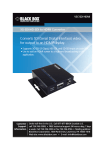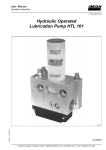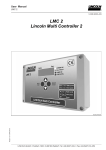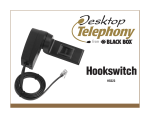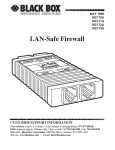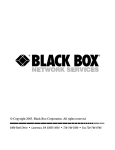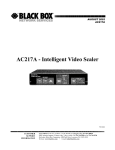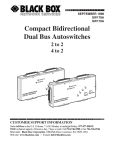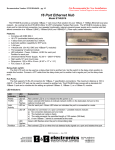Download LineShare 1 x 4
Transcript
JULY 1997 FX145A LineShare 1 x 4 ger 1x4 e Mana in Phone L P4 P3 P2 P1 CUSTOMER SUPPORT INFORMATION Order toll-free in the U.S. 24 hours, 7 A.M. Monday to midnight Friday: 877-877-BBOX FREE technical support, 24 hours a day, 7 days a week: Call 724-746-5500 or fax 724-746-0746 Mail order: Black Box Corporation, 1000 Park Drive, Lawrence, PA 15055-1018 Web site: www.blackbox.com • E-mail: [email protected] FCC AND DOC/MDC STATEMENTS FEDERAL COMMUNICATIONS COMMISSION and INDUSTRY CANADA RADIO FREQUENCY INTERFERENCE STATEMENT Class B Digital Device. This equipment has been tested and found to comply with the limits for a Class B computing device pursuant to Part 15 of the FCC Rules. These limits are designed to provide reasonable protection against harmful interference in a residential installation. However, there is no guarantee that interference will not occur in a particular installation. This equipment generates, uses, and can radiate radio frequency energy, and, if not installed and used in accordance with the instructions, may cause harmful interference to radio communications. If this equipment does cause harmful interference to radio or telephone reception, which can be determined by turning the equipment off and on, the user is encouraged to try to correct the interference by one of the following measures: • Reorient or relocate the receiving antenna. • Increase the separation between the equipment and receiver. • Connect the equipment into an outlet on a circuit different from that to which the receiver is connected. • Consult an experienced radio/TV technician for help. Caution: Changes or modifications not expressly approved by the party responsible for compliance could void the user’s authority to operate the equipment. To meet FCC requirements, shielded cables and power cords are required to connect this device to a personal computer or other Class B certified device. This digital apparatus does not exceed the Class B limits for radio noise emission from digital apparatus set out in the Radio Interference Regulation of industry Canada. Le présent appareil numérique n’émet pas de bruits radioélectriques dépassant les limites applicables aux appareils numériques de classe B prescrites dans le Règlement sur le brouillage radioélectrique publié par Industrie Canada. 3 LINESHARE 1 x 4 NORMAS OFICIALES MEXICANAS (NOM) ELECTRICAL SAFETY STATEMENT INSTRUCCIONES DE SEGURIDAD 1. Todas las instrucciones de seguridad y operación deberán ser leídas antes de que el aparato eléctrico sea operado. 2. Las instrucciones de seguridad y operación deberán ser guardadas para referencia futura. 3. Todas las advertencias en el aparato eléctrico y en sus instrucciones de operación deben ser respetadas. 4. Todas las instrucciones de operación y uso deben ser seguidas. 5. El aparato eléctrico no deberá ser usado cerca del agua—por ejemplo, cerca de la tina de baño, lavabo, sótano mojado o cerca de una alberca, etc. 6. El aparato eléctrico debe ser usado únicamente con carritos o pedestales que sean recomendados por el fabricante. 7. El aparato eléctrico debe ser montado a la pared o al techo sólo como sea recomendado por el fabricante. 8. Servicio—El usuario no debe intentar dar servicio al equipo eléctrico más allá a lo descrito en las instrucciones de operación. Todo otro servicio deberá ser referido a personal de servicio calificado. 9. El aparato eléctrico debe ser situado de tal manera que su posición no interfiera su uso. La colocación del aparato eléctrico sobre una cama, sofá, alfombra o superficie similar puede bloquea la ventilación, no se debe colocar en libreros o gabinetes que impidan el flujo de aire por los orificios de ventilación. 10. El equipo eléctrico deber ser situado fuera del alcance de fuentes de calor como radiadores, registros de calor, estufas u otros aparatos (incluyendo amplificadores) que producen calor. 11. El aparato eléctrico deberá ser connectado a una fuente de poder sólo del tipo descrito en el instructivo de operación, o como se indique en el aparato. 4 NOM STATEMENT 12. Precaución debe ser tomada de tal manera que la tierra fisica y la polarización del equipo no sea eliminada. 13. Los cables de la fuente de poder deben ser guiados de tal manera que no sean pisados ni pellizcados por objetos colocados sobre o contra ellos, poniendo particular atención a los contactos y receptáculos donde salen del aparato. 14. El equipo eléctrico debe ser limpiado únicamente de acuerdo a las recomendaciones del fabricante. 15. En caso de existir, una antena externa deberá ser localizada lejos de las lineas de energia. 16. El cable de corriente deberá ser desconectado del cuando el equipo no sea usado por un largo periodo de tiempo. 17. Cuidado debe ser tomado de tal manera que objectos liquidos no sean derramados sobre la cubierta u orificios de ventilación. 18. Servicio por personal calificado deberá ser provisto cuando: A: El cable de poder o el contacto ha sido dañado; u B: Objectos han caído o líquido ha sido derramado dentro del aparato; o C: El aparato ha sido expuesto a la lluvia; o D: El aparato parece no operar normalmente o muestra un cambio en su desempeño; o E: El aparato ha sido tirado o su cubierta ha sido dañada. 5 LINESHARE 1 x 4 Contents Chapter Page 1. Specifications ............................................................................................. 7 2. Introduction ............................................................................................... 8 3. Installation .................................................................................................. 9 3.1 Installing a Single LineShare 1 x 4 .................................................... 9 3.2 Installing Multiple LineShare 1 x 4s in a Cascade or Daisychain ................................................................... 11 4. Operation and Troubleshooting ............................................................ 13 4.1 Contacting Black Box ....................................................................... 13 4.2 Shipping and Packaging ................................................................... 14 6 CHAPTER 1: Specifications 1. Specifications Compliance — FCC Part 15 Class B, DOC Class/MDC classe B; FCC Part 68 (registration number BZQUSA-18976-KX-N); DOC approval number 1081 4273A Ringer Equivalency — 0.3 B DOC Load — 10 Data Rate — Transparent to data rate On-Hook Voltage — 36 VDC ±10% at normal input voltage User Controls — None Indicators — (4) Front-mounted port-activity LEDs Connectors — All rear-mounted: (5) RJ-11C female: (4) input, (1) output; (1) Barrel jack for power MTBF — 56,200 hours Temperature Tolerance — Operating: 5 to 113˚ F (–15 to 45˚ C); Storage: –40 to 158˚ F (–40 to 70˚ C) Humidity Tolerance — Up to 85% noncondensing Power — From wallmount power supply: Input: 120 VAC RMS, 50 to 60 Hz, 17 watts; Output: 12 VAC RMS at 830 mA Size — 2"H x 6.5"W x 7.3"D (5.1 x 16.5 x 18.4 cm) Weight — 3 lb. (1.4 kg) 7 LINESHARE 1 x 4 2. Introduction The LineShare 1 x 4 (just “1 x 4” for short) makes it easy to attach four or more different outbound-only phones, modems, faxes, etc., to the same phone line. No more flipping switches or turning machines on and off; the 1 x 4 is fully automatic. When any device attached to the 1 x 4 is using the line, the 1 x 4 will simply send a busy signal to any of the other attached devices if they try to pick up. This capability, called “port exclusion,” means that your important conversations and data transfers won’t be interrupted by activity on the other devices. Once a device goes off hook, the LineShare 1 x 4 will maintain exclusion until that device hangs up. Each attached device is allowed unlimited individual connection time. You can tell, with a glance at the four LEDs on the LineShare 1 x 4’s front panel, which device is using the line at any given moment. The LineShare 1 x 4 is for outbound calls only. This makes it ideal for applications involving intermittent access to the Internet or online services by multiple users. (The 1 x 4 can’t detect inbound calls; it will not answer them or transfer them in any way, and it does not ring—although callers on the other end will hear a ring signal until they hang up. If one of the attached devices should happen to go off-hook while an inbound call is being attempted, a brief connection will be made, but attached modems and faxes will just hang up again unless they are specifically directed to answer—which would require either a human picking up first and recognizing the call, or some very precise mutually agreed-upon timing.) You can attach all kinds of phone and telecommunication equipment to the LineShare 1 x 4; it is compatible with any telephone device that responds to a standard phone-company ring signal. Because it maintains an on-hook voltage of 36 volts, you can even attach credit-card authorization terminals to the 1 x 4. If you need more than four devices to share a single line, you can even daisychain or cascade LineShare 1 x 4s (see Section 3.2). It is even possible to install the LineShare 1 x 4 on a line carrying one or more other, non-attached devices. When any of these are using the line, the 1 x 4 will give the busy signal to its attached devices; but it cannot provide a busy signal to non-attached devices, and if they pick up while an attached device is using the line, existing phone connections might be degraded or interrupted. 8 CHAPTER 3: Installation 3. Installation 3.1 Installing a Single LineShare 1 x 4 Take these steps to install a single LineShare 1 x 4 and attach as many as four devices to it (refer to Figure 3-1 on the next page): 1. Place the LineShare 1 x 4 in a cool dry place within 5 ft. (1.5 m) of a utility-power wall outlet, as close as possible to the devices you want to attach to it. (It should also be within 7 ft. [2.1 m] of the phone jack if you want to use our included phone cable.) 2. Plug the output cord of the 1 x 4’s power supply into the barrel jack marked “12 VAC” on the unit’s rear panel, then plug the power supply’s transformer into the wall outlet. 3. Run a regular telephone cord (either the one we supply with the unit or one of your own) from the 1 x 4’s “LINE” port to a phone-line jack. 4. Run other regular telephone cords from Ports 1, 2, 3, and 4 to the devices you want to attach to them (the devices that will be sharing the line). You can use the phone cords that came with these devices. That’s all there is to it. Your LineShare 1 x 4 system should be ready for continuous operation. 9 LINESHARE 1 x 4 Wall Outlet Phone Jack LINE PORT 1 PORT 2 PORT 3 PORT 4 12V AC Power Supply Single Phone Cable Phone Cables to Computer Modems Figure 3-1. Typical application: Installing a single LineShare 1 x 4. 10 CHAPTER 3: Installation 3.1 Installing Multiple LineShare 1 x 4s in a Daisychain or Cascade To have more than four devices share a single phone line, you will need to install two or more LineShare 1 x 4s interconnected in a cascade or daisychain (refer to Figure 3-2 on the next page). Each extra 1 x 4 adds another three “LINE IN” ports to the system (the four on the extra 1 x 4 minus the one it is occupying on the previously installed 1 x 4). Take these steps: 1. Place the first LineShare 1 x 4 in a cool dry place within 5 ft. (1.5 m) of a utility-power wall outlet. (It should also be within 7 ft. [2.1 m] of the phone jack if you want to use our included phone cable.) 2. Plug the output cord of the first 1 x 4’s power supply into the barrel jack marked “12 VAC” on the unit’s rear panel, then plug the power supply’s transformer into a wall outlet. 3. Run a regular telephone cord (either the one we supply with the unit or one of your own) from the first 1 x 4’s “LINE” port to a phone-line jack. 4. Place the second LineShare 1 x 4 within 5 ft. (1.5 m) of a utility-power wall outlet. (It should also be within 7 ft. [2.1 m] of the first 1 x 4 if you want to use our included phone cable to connect the two units.) 5. Plug the output cord of the second 1 x 4’s power supply into the barrel jack marked “12 VAC” on the unit’s rear panel, then plug the power supply’s transformer into the wall outlet. 6. Run a regular telephone cord (either the one we supply with the unit or one of your own) from the second 1 x 4’s “LINE” port to Port 1, 2, 3, or 4 of the first 1 x 4. 7. To add a third or subsequent LineShare 1 x 4: Place it within 5 ft. (1.5 m) of a utility-power wall outlet. (It should also be within 7 ft. [2.1 m] of any other previously installed LineShare 1 x 4 if you want to use our included phone cable to connect the two units.) Plug the output cord of this 1 x 4’s power supply into the barrel jack marked “12 VAC” on the unit’s rear panel, then plug the power supply’s transformer into the wall outlet. Then run a regular telephone cord (either the one we supply with the unit or one of your own) from its “LINE” port to Port 1, 2, 3, or 4 of one of the other 1 x 4s. 11 LINESHARE 1 x 4 8. Run other regular telephone cords from any of the remaining ports on any of the 1 x 4s to the devices you want to attach to them (the devices that will be sharing the line). You can use the phone cords that came with these devices. Your LineShare 1 x 4 system should now be ready for continuous operation. LINE PORT 1 PORT 2 PORT 3 PORT 4 12V AC LINE PORT 1 PORT 2 PORT 3 PORT 4 12V AC LINE PORT 1 PORT 2 PORT 3 PORT 4 12V AC Figure 3-2. Daisychaining multiple LineShare 1 x 4s (a three-unit, ten-port system is shown). 12 CHAPTER 4: Operation and Troubleshooting 4. Operation and Troubleshooting If your LineShare 1 x 4 system is installed correctly, it should operate continuously without user intervention. As different attached devices access the line, the port-activity LEDs on the LineShare 1 x 4 units will show which one is using the line at any given time. All other attached devices will be excluded from the line and be sent a busy signal while any attached device, or any other device on the same line, is using the line. If you ever have any trouble with your LineShare 1 x 4 system, follow the instructions in the rest of this chapter. 4.1 Contacting Black Box If you determine that your LineShare 1 x 4 is malfunctioning, do not attempt to alter or repair it. It contains no user-serviceable parts. Contact Black Box Technical Support at (724) 746-5500. The problem might be solvable over the phone. Before you do, make a record of the history of the problem. We will be able to provide more efficient and accurate assistance if you have a complete description, including: • The nature and duration of the problem. • When the problem occurs. • The components involved in the problem. • Any particular application that, when used, appears to create the problem or make it worse. 13 LINESHARE 1 x 4 4.2 Shipping and Packaging If you need to transport or ship your LineShare 1 x 4: • Package it carefully. We recommend that you use the original container. • Before you ship a unit for repair or return, contact Black Box to get a Return Materials Authorization (RMA) number, and make sure you include everything you received with the unit when you ship it. 14 © Copyright 1997. Black Box Corporation. All rights reserved. 1000 Park Drive • Lawrence, PA 15055-1018 • 724-746-5500 • Fax 724-746-0746














